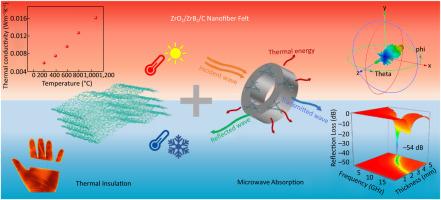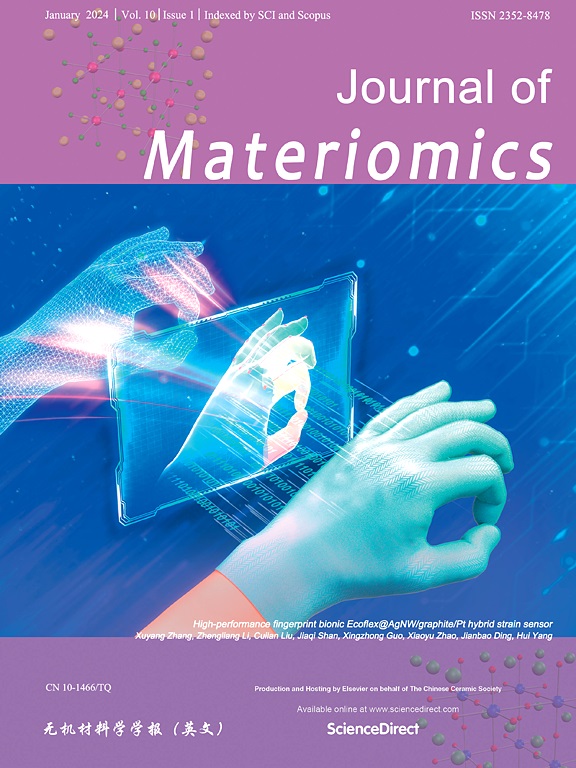Flexible ZrO2/ZrB2/C nanofiber felt with enhanced microwave absorption and ultralow thermal conductivity
IF 9.6
1区 材料科学
Q1 CHEMISTRY, PHYSICAL
引用次数: 0
Abstract
Carbon-based materials, renowned for their low density, adjustable electrical conductivity, superior corrosion resistance and mechanical properties, and have found extensive applications in the field of electromagnetic wave absorption (EMWA). Despite their merits, the current EMWA and thermal insulation capabilities are not fully optimized, thereby restricting their applications in the aerospace sector. Herein, we introduce a combinatory methodology employing electrospinning followed by pyrolysis to in-situ integrate ZrO2 and ZrB2 nanoparticles onto the surface of carbon nanofibers, culminating in a flexible ZrO2/ZrB2/C nanofiber felt. The integration of ZrO2 and ZrB2 nanoparticles significantly augments impedance matching and promotes multifaceted scattering and interfacial polarization. Consequently, the ZrO2/ZrB2/C nanofiber felt demonstrates a minimum reflection loss (RLmin) of −54 dB and the effective absorption bandwidth (EAB, RL ≤ −10 dB) is 3.1 GHz. Moreover, the three-dimensional porous architecture and the presence of multiple heterogeneous interfaces endow the ZrO2/ZrB2/C nanofiber felt with an ultralow thermal conductivity of 0.016 W⸱m−1⸱K−1 at 1100 °C, underscoring its exceptional potential for infrared stealth. This work shows considerable guiding significance for the design of bi-functional EMWA materials with ultralow thermal conductivity in aerospace field.


柔性ZrO2/ZrB2/C纳米纤维毡,增强微波吸收和超低导热
碳基材料以其低密度、可调电导率、优异的耐腐蚀性和机械性能而闻名,在电磁波吸收(EMWA)领域得到了广泛的应用。尽管有其优点,但目前的EMWA和隔热能力并没有得到充分优化,从而限制了它们在航空航天领域的应用。本文采用静电纺丝和热解相结合的方法,将ZrO2和ZrB2纳米颗粒原位整合到纳米碳纤维表面,最终得到具有柔性的ZrO2/ZrB2/C纳米纤维毡。ZrO2和ZrB2纳米粒子的集成显著增强了阻抗匹配,促进了多面散射和界面极化。因此,ZrO2/ZrB2/C纳米纤维毡的最小反射损耗(RLmin)为-54 dB,有效吸收带宽(EAB, RL≤-10 dB)为3.1 GHz。此外,三维多孔结构和多种非均质界面的存在使ZrO2/ZrB2/C纳米纤维毡在1100℃时具有0.016 W⸱m−1⸱K−1的超低导热系数,突出了其特殊的红外隐身潜力。该工作对航空航天领域双功能超低导热EMWA材料的设计具有重要的指导意义。
本文章由计算机程序翻译,如有差异,请以英文原文为准。
求助全文
约1分钟内获得全文
求助全文
来源期刊

Journal of Materiomics
Materials Science-Metals and Alloys
CiteScore
14.30
自引率
6.40%
发文量
331
审稿时长
37 days
期刊介绍:
The Journal of Materiomics is a peer-reviewed open-access journal that aims to serve as a forum for the continuous dissemination of research within the field of materials science. It particularly emphasizes systematic studies on the relationships between composition, processing, structure, property, and performance of advanced materials. The journal is supported by the Chinese Ceramic Society and is indexed in SCIE and Scopus. It is commonly referred to as J Materiomics.
文献相关原料
公司名称
产品信息
阿拉丁
N-Propyl zirconate (Zr(OPr)4)
阿拉丁
polyvinyl pyrrolidone (PVP, Mw=1,300,000)
阿拉丁
N-Propyl zirconate (Zr(OPr)4)
阿拉丁
polyvinyl pyrrolidone (PVP, Mw=1,300,000)
阿拉丁
N-Propyl zirconate (Zr(OPr)4)
阿拉丁
polyvinyl pyrrolidone (PVP, Mw=1,300,000)
 求助内容:
求助内容: 应助结果提醒方式:
应助结果提醒方式:


